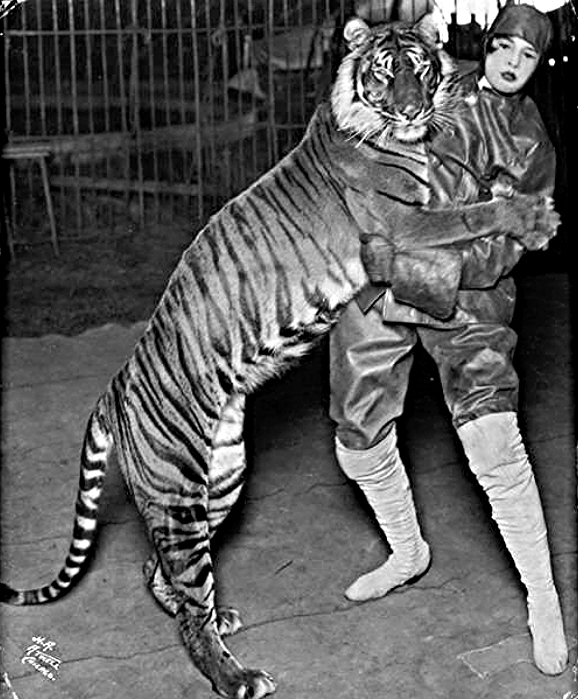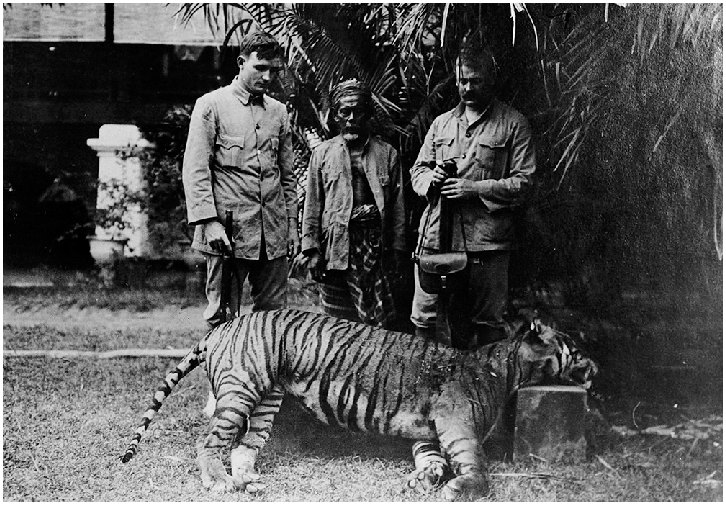Panthera tigris balica Schwarz, 1912:325
Bali tiger, Balinese tiger
Taxonomy & Nomenclature
Synonym/s: Panthera sondaica balica, Schwarz 1912:325
Conservation Status
Extinct
Last record: 27 September 1937
IUCN status: Extinct
The Bali tiger was endemic to the Indonesian island of Bali. It's population size was therefore constrained because of this restricted geography. The Bali tiger was the smallest of the historical tiger subspecies. It was much prized as a hunting trophy, and expeditions to capture such a prize never really abated, even when it was close to extinction. The last known tiger, a tigress, was shot in the wild on the 27th September 1937, at Sumbar Kima (west Bali). A survival date into the 1940's is possible.
Several claims of sightings into the 1970's and beyond must be looked at with extreme skepticism, as the island of Bali is so small that a viable population of Bali tiger could not really evade locals. These may simply be tigers of other subspecies, released illegally by their owners after they became too much to care for. People living on Bali have been found in possession of tigers of the Sumatran subspecies (Shepherd & Magnus, 2004:64), and it is not inconceivable that some unscrupulous persons have simply let them go. This seems the most reasonable explanation when compared with the other alternatives: that these reports are hoaxes, or that they are genuine misidentification's.
Distribution
Bali, Indonesia
Biology & Ecology
Hypodigm
Mazák et. al. (1978) listed all known material belonging to the Bali tiger which consisted of eight skulls, five skins and some limb bones. A 9th skull (HNHM 4250.17) was reported by (Buzás & Farkas, 1997). Yamaguchi et al. (2013) found 11 Balinese tiger specimens.
Media
Historical photos
Source: https://www.extinctanimals.org/bali-tiger.htm

Above: Bali tiger killed by Baron Oscar Vojnich (seated to left of tiger's head), 3 November 1911. Source: Wikimedia Commons.

Above: Bali tiger killed by Baron Oscar Vojnich (standing with rifle to left of tiger), 3 November 1911. Source: Wikimedia Commons.

Above: Bali tiger with tamer Rose Flanders Bascom at Ringling Bros circus, pre-1915. Source: Wikimedia Commons.

Above: Bali tigers with trainer at Ringling Bros circus, c.1915. Source: Rossi et al. (2020:399).

Above: Bali tiger shot by Cecil HH Heaps (far right) c.1916. Source: Yamaguchi et al. (2013).

Above: Bali tiger killed by M. Zanveld. Source: Wikimedia Commons.

Above: a possible Bali tiger in captivity. Source: https://www.instagram.com/p/BzcezHsjR94/
References
Original scientific description:
Schwarz, E. (1912). Notes on Malay tigers, with description of a new form from Bali. Ann. Mag. Nat. Hist. 10: 324-326.
Other references:
Anonymous. (1964). A preliminary list of rare mammals including those believed to be rare but concerning which detailed information is still lacking. IUCN Bulletin 11(Special Supplement): 4 pp.
Ashraf, M. A. (2006). The extirpation of Bali and Javan tiger: lessons from the past. Tigerpaper 33(3): 3-8.
Brink, J. van den. (1980). The former distribution of the Bali tiger, Panthera tigris balica (Schwarz, 1912). Säugetierk. Mitt. 28: 286-289.
Buzás, B. and Farkas, B. (1997). An additional skull of the Bali tiger, Panthera tigris balica (Schwarz) in the Hungarian Natural History Museum. Miscellanea Zoologica Hungarica 11: 101-105.
Buzás, B. and Farkas, B. (1998). Death of a Bali tiger. Cat News 28: 7. [edited excerpt from Buzás & Farkas, 1997]
Day, David. (1981). The Doomsday Book of Animals: A Natural History of Vanished Species. New York, N.Y.: The Viking Press.
de Iongh, H.H, Komara, A., Moeliono, M., Pratjihno, P.S., Spliethof, P.C. & Soenarja, I.S. (1979) Report on a survey of the Bali tiger (Panthera tigris balica Schwarz 1912) and Bali mynah (Leucopsar rothschildi Stresemann 1912). March–April 1979. Van Tienhovens Foundation, Amsterdam. [in Indonesian]
Goodwin, Harry A. and Goodwin, J. M. (1973). List of mammals which have become extinct or are possibly extinct since 1600. Int. Union Conserv. Nat. Occas. Pap. 8: 1-20.
Hemmer, H. (1969). Zur Stellung des Tigers (Panthera tigris) der Insel Bali. Z. Säugetierkunde 34: 216-223.
Jackson, P. & Nowell, K. (2008). Panthera tigris ssp. balica. In: IUCN 2011. IUCN Red List of Threatened Species. Version 2011.2. (http://www.iucnredlist.org). Downloaded on 15 April 2012.
Jackson, P. & Nowell, K. 2008. Panthera tigris ssp. balica. The IUCN Red List of Threatened Species 2008: e.T41682A10510320. https://dx.doi.org/10.2305/IUCN.UK.2008.RLTS.T41682A10510320.en. Accessed on 04 July 2022.
Joslin, Paul and Maryanka, Daphne. (1968). Endangered Mammals of the World: Report on Status and Action Treatment. IUCN Publications, New Series, Supplementary Paper No. 13: 34 pp.
Mazák, V. (1976). On the Bali Tiger, Panthera tigris balica (Schwarz, 1912). Acta Soc. Zool. Bohemoslov. 40: 179-195.
Mazak, J. H. and Groves, Colin P. (2006). A taxonomic revision of the tigers (Panthera tigris) of Southeast Asia. Mammalian Biology 71: 268-287.
Mazák, V., Groves, C.R & Bree, R. J. H. van. (1978). On a skin and skull of the B a li Tiger, and a list of preserved specimens of Panthera tigris balica (Schwarz, 1912). Z. Säugetierkunde 43: 108-113.
Nowell, K. and Jackson, P. 1996. Wild Cats. Status Survey and Conservation Action Plan. IUCN/SSC Cat Specialist Group, Gland, Switzerland and Cambridge, UK.
Pocock, R . I. (1929). Tigers. J. Bombay Nat. Hist. Soc. 33: 505-541.
Rossi, L., Scuzzarella, C. M. and Angelici, F. M. (2020). Extinct or Perhaps Surviving Relict Populations of Big Cats: Their Controversial Stories and Implications for Conservation, pp. 393-417. In: Angelici F., Rossi L. (eds.). Problematic Wildlife II. Cham: Springer.
Schwarz, E. (1913). Der Bali-Tiger. Bet: Senckenb. Naturf. Ges. 44: 70-73.
Scott, Peter (ed.). (1965). Section XIII. Preliminary List of Rare Mammals and Birds, pp. 155-237. In: The Launching of a New Ark. First Report of the President and Trustees of the World Wildlife Fund. An International Foundation for saving the world's wildlife and wild places 1961-1964. London: Collins.
Seidensticker, J. (1987). Bearing witness: Observations on the extinction of Panthera tigris balica and Panthera tigris sondaica. In: R. L. Tilson and U. S. Seal (eds), Tigers of the World: The biology, biopolitics, management and conservation of an endangered species, pp. 1-8. Noyes, Park Ridge, NJ, USA.
Shepherd, Chris R. and Magnus, Nolan (2004). Nowhere to hide: The trade in Sumatran Tiger. TRAFFIC Southeast Asia.
Sody, H.J.V. (1932). The Balinese tiger, Panthera tigris balica (Schwarz). J. Bombay Nat. Hist. Soc. 36: 233-235.
Vojnich, O. (1913). A Kelet-indiai Szigetcsoporton [In the East Indian Archipelago]. Singer & Wolfner, Budapest, 264 pp.
Whitten T, Soeriatmadja RE, Afiff SA. 1999. Ecology of Java and Bali. Prenhallindo, Jakarta. [Indonesian].
Xue, Hao-Ran et al. (2015). Genetic Ancestry of the Extinct Javan and Bali Tigers. Journal of Heredity 106(3): 247-257.
Yamaguchi, Nobuyuki et al. (2013). Locating Specimens of Extinct Tiger (Panthera tigris) Subspecies: Javan Tiger (P. T. sondaica), Balinese Tiger (P. T. balica), and Caspian Tiger (P. T. virgata), Including Previously Unpublished Specimens. Mammal Study 38(3): 187-198. [Abstract]
http://extinctanimals.proboards.com/thread/7441/balinese-tiger-panthera-tigris-balica

